The best 4K Blu-ray players 2024: Ultra HD marvels chosen by our experts
The best 4K Blu-ray players for movie lovers
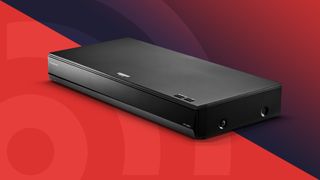
1. The quick list
2. Best for most people
3. Best budget
4. Best premium
5. Best for audiophiles
6. Best games console
7. Great for home entertainment
8. How to choose
9. How we test
10. New 4K releases
11. Latest updates
The best 4K Blu-ray players deliver the ultimate picture quality for watching movies and TV series at home. Although streaming services are popular, Blu-rays deliver video at a higher bitrate, bringing you more detail and realism. There are other benefits to Blu-rays, like the fact you truly own your movie collection, and get stunning box art and behind-the-scenes extras that come on the disc.
It’s no surprise home theater lovers say one of the best 4K Ultra HD Blu-ray players is essential – however, with the rise of streaming services, dedicated disc players are less common. This is a shame, considering that these are the ultimate way to show off one of the best TVs, and their uncompressed sound helps make the most of the best soundbars or best home theater systems.
It may not be a very vibrant market now – you'll notice all our top picks are from Panasonic, which dominates this field now, with Sony also still offering some options – but there are models across different budget ranges. We've tested these models, using them with elite TVs to show off their potential. We've also included the latest Xbox and PlayStation consoles in this round-up, because they support 4K Blu-Ray discs too, but we address them separately after the dedicated players.

James is TechRadar's TV Hardware Staff Writer, and has reviewed everything from budget 32-inch TVs up to the world’s most elite OLED TVs. Before joining TechRadar, he worked for several years at one of the UK's leading AV retailers, dealing with everything from Bluetooth speakers to custom home theater installations. He recently refreshed this guide based on his own testing and reviews of the products within our labs.
The quick list
Looking for a quick run-down of the best 4K Blu-ray players? Check out the list below which summarizes each entry in this list. If you're looking for a more detailed look at each entry, you can jump down to a more detailed review of each player.
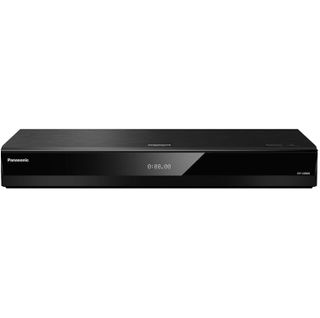
The best 4K Blu-ray player for most people
Excellent picture and audio reproduction, plenty of connectivity and features, and build quality that we know lasts for years – for a seriously good price.

The best budget 4K Blu-ray player
If you want great quality picture from your 4K Blu-ray player picture for cheap, this is the go-to option. It may be light on features, but its performance more than makes up for it.
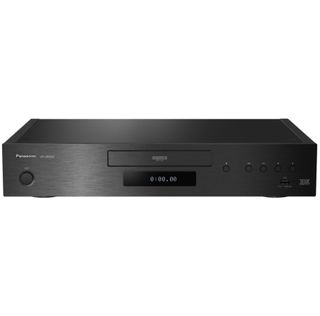
The best premium 4K Blu-ray player
It may be premium in price, but it's also premium in performance and design. If you're looking for the best picture playback you can get, look no further.
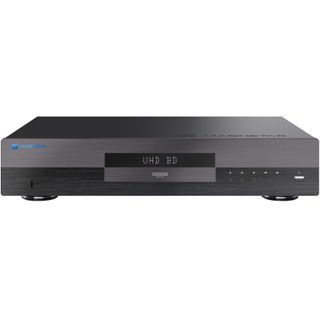
The best 4K Blu-ray player for audiophiles
If audio is just as, if not more, important in your 4K Blu-ray player than video, the Magnetar UDP800 offers exceptional audio playback quality and compatibility.
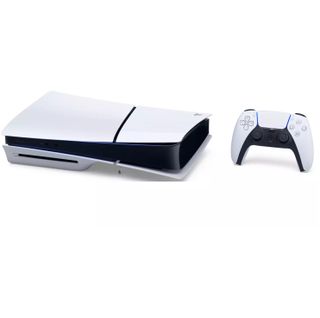
The best games console for 4K Blu-ray
If you're wondering which games console to get for your 4K Blu-rays, it's the PS5. We found that its picture quality for discs was sharper than the Xbox Series X.
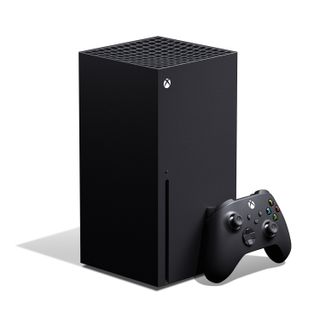
Great for home entertainment
Blu-rays may look better on the PS5, but the Xbox Series X is still a great 4K player. It also has Dolby Vision support for streaming and video games (not Blu-rays), which the PS5 doesn't.
The best Blu-ray players 2024: the list
Why you can trust TechRadar
The best 4K Blu-ray for most people

Specifications
Reasons to buy
Reasons to avoid
The Panasonic DMP-UB820 is easily the best 4K Blu-ray player on the market for most people. It offers full HDR support, plenty of connectivity options with up to 7.1 channels of analogue audio output, Wi-Fi capabilities including video streaming, and varied playback functionality. And as an added bonus, it comes at a very competitive price.
Picture quality on the Panasonic DP-UB820 is fantastic, with 4K HDR images looking particularly brilliant. Colors are punchy, textures are sharp and defined, and black tones are accurate. We found during our testing that this was the case across the board, whether it was 4K Blu-ray, standard Blu-ray and even DVD. In our review, we said "Its 4K upscaling is effective, giving regular (non-4K) Blu-ray a whole new level of detail". So for those looking to get that little bit extra out of their Blu-ray picture, the DP-UB820 is here to help.
Audio is another of the UB820's strengths, with excellent Dolby Atmos reproduction in particular. During testing, we found that even through a mid-range Dolby Atmos soundbar, the room-filling effect we were looking for was still present. The UB820 also boasts different external audio connections including a dedicated HDMI audio output and up to 7.1 channels of direct analogue audio output for those with a home theater setup.
The Panasonic DP-UB820 offers stunning picture and audio reproduction at an outstanding price – and on top of this, it provides phenomenal value thanks to its rock-solid design. We've seen one run daily in a demo environment for years without breaking. If you buy this 4K Blu-ray player, it will most definitely give you a long life of entertainment.
Read our full Panasonic DP-UB820 review
Best budget 4K Blu-ray player
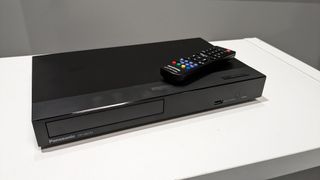
Specifications
Reasons to buy
Reasons to avoid
One of Panasonic's more budget-friendly 4K Blu-ray players, the Panasonic DP-UB154 gives you real value for money. It may be light on connections, but its picture quality more than makes up for this. As a bonus, it's also very competitively priced, currently sitting around the $169/£159 mark.
One thing that we have noticed is that the DP-UB154 isn't readily available all the time so if you find this to be the case, look out for the Panasonic DP-UB150, which in terms of specs is virtually the same as the DP-UB154.
Contrast and natural textures are the UB154's real picture strengths, making any movie thrown at it look great. Its 4K upscaling really brings something new to non-4K discs, bringing extra detail. In our review we said, when viewing Godzilla vs Kong on 4K, that "the neon streets of Tokyo were bold, vibrant and as eye-wateringly garish as I hoped during the climactic fight scene between Godzilla and Kong".
Admittedly, it isn't all perfect, as the UB154 has no Dolby Vision, no Wi-Fi, its response times can be on the slow side, and its design is fairly safe, if not a bit boring – but the impressive picture and budget-friendly price really do make this a top choice for people looking for a cheap 4K Blu-ray player.
Read our full Panasonic DP-UB154 review
Best premium 4K Blu-ray player
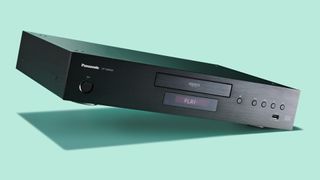
Specifications
Reasons to buy
Reasons to avoid
The DP-UB9000 is Panasonic’s flagship 4K Ultra HD Blu-ray player, and it's the model to buy if you have an elite home theater setup and need something that can really push it to the max. It's beautifully made, enviably specified and unashamedly premium. The heavy metal build and luxe design mean it feels high-end too.
It's not just a pretty face. The DP-UB9000 was the first UHD deck from Panasonic to support all the key HDR formats: vanilla HDR10, its dynamic sibling HDR10+, HLG and Dolby Vision. (The Panasonic DP-UB820 at the top of our list supports all these formats too, though.)
When we tested the DP-UB9000 we were as impressed by its audio as by its image quality. It boasts high-quality DACs, two-channel and 7.1-channel analogue outputs, and Hi-Res Audio support. Toss in a host of smart features, and the UB9000 ticks nearly every box in our book.
Naturally all of these flagship features don’t come cheap. However, for those seeking the best Blu-ray playback around and don't mind about it lacking some audio disc support, look no further. In our review we wrote: "Its picture performance and overall build quality actually make that lofty price tag look like a steal while cinematic imagery, full HDR compatibility and that powerful HDR optimizer, make this player a must-have for videophiles."
Read our full Panasonic DP-UB9000 review
Best 4K Blu-ray player for audiophiles

Specifications
Reasons to buy
Reasons to avoid
Magnetar is a relative newcomer to the 4K Blu-ray world, though it's from the same company as Reavon, which has made players for a while – and like Reavon players, the Magnetar is a seriously premium piece of hardware, weighing in at hefty 8kg, keeping those discs totally stable. Speaking of discs, it not only supports all Blu-ray formats, but is also generous with its audio disc support, including DVD-Audio and SACD.
The UDP800 is a not just a powerhouse when it comes to picture, which we said in our review "conveys all the luster and near three-dimensional texture you would hope for", but also when it comes to audio, thanks to the built-in Burr-Brown PCM 1795 stereo DAC (32-bit, 192kHz) and balanced XLR stereo outputs.
When we listened to a recording of The Earth Overture by Kosuke Yamashita, which was in 96kHz, 24-bit 7.1 (we listened to in linear PCM) we said it "sounds superb, with crystal clarity and hugely dynamic fanfares. It's like sitting amidst the orchestra."
With SACD and DVD-Audio playback as well, this really is an excellent option if you're looking to get just as much from the audio side of things as your movies from your 4K Blu-ray player.
There are no streaming options here, outside of basic file playback over UPnP from a local server – and even for that, you need a wired connection, because there's no Wi-Fi. There two two HDMI outputs – one standard, and one audio only – plus stereo analog outputs.
If you are looking for 7.1 analog audio outputs, sadly you won't find them here. Your best bet if you want this while keeping the SACD playback is the Reavon UBR-X200, however do note that UBR-X200 doesn't have DVD-Audio playback or HDR10+ HDR format compatibility.
Read our full Magnetar UDP800 review
Best games console for 4K Blu-ray

Specifications
Reasons to buy
Reasons to avoid
The Sony PS5 Slim is helping to keep 4K Blu-ray technology alive with its dedicated disc drive – in the mainline console, at least. While you can buy a slightly cheaper discless version, it's the standard-edition console we're interested in here. The PS5 Slim's disc drive can play 4K Blu-rays – which is fitting, since Sony helped to popularize Blu-ray players with the PS3 two whole console generations ago.
As an all-round media center, the PS5 isn't quite as advanced as the Xbox Series X, largely because it doesn't support Dolby Vision HDR over streaming. However, both consoles can pass Dolby Atmos and DTS:X soundtracks through to your TV (with some minor tinkering in the Settings), and neither console supports Dolby Vision HDR or HDR10+ from Blu-rays, so actually the PS5 isn't at any disadvantage for discs compared to the Xbox.
Where it does have an advantage, though, is picture quality. In our tests (done on the original PS5 model rather than the slim, but both have the same tech inside) we found that the PS5's image is cleaner and shaper for native 4K than the Xbox, and it upscales HD Blu-rays with more natural results. So we think of the two consoles the Sony is the better Blu-Ray player – we explain more in our dedicated guide to whether the PS5 is a good Blu-ray player. Just make sure you buy the version that actually plays discs!
Below is a link to our review of the original PS5 console, which carries the same capabilities as the PS5 Slim, just in a bulkier body.
Read our full PS5 review
A games console that's great for home entertainment

Specifications
Reasons to buy
Reasons to avoid
If you're sussing out a gaming console to play your 4K Blu-rays and DVDs, it's worth keeping in mind the Xbox Series X. It supports Dolby Vision HDR, unlike the PS5, but only from streaming services – this doesn't extend to the disc drive, hence why the console is so low in this list. (You'll only get regular HDR10 over disc.)
It supports Dolby Atmos audio (including out to headphones, for a fee), but probably more usefully it passes Atmos or DTS:X soundtracks through to your TV to handle, when set up properly. We did find that it could be picky about passing DTS:X through a TV that doesn't support it to a sound system that does, though.
In our tests we also found that the 4K image quality and HD upscaling were both a little weaker from the Xbox Series X than the PS5. So we'd pick the PS5 if you're serious about playing UHD discs, but you can read more about the Xbox's disc support in our dedicated guide to whether the Xbox Series X is a good Blu-ray player.
The Xbox Series X does still serve as a great choice if you're after a 'home entertainment' system, as it gives you Dolby Vision streaming and gaming along with basic 4K Blu-ray playback.
Read our full Xbox Series X review
How to choose the best 4K Blu-ray player for you
If you've decided that you want to watch your movies and TV shows on a 4K Blu-ray player (good choice), what are some of the key things you need to look out for?
A top consideration is price. You do tend to get what you pay for when it comes to Blu-ray players—and we wouldn't consider them an essential piece of kit—but there are cheap(ish) options. For example, the Sony UBP-X700 in our list above brings you all of the basics for only $259.99/£229—or even less during the sales.
You also need to consider compatibility and your current set-up. To make the most of a new 4K Blu-ray player you'll need a 4K TV, although it will still work on an HD display the picture quality will be limited to only 1080p.
It may seem obvious, but you'll also want to think about the design and size of the Blu-ray player. Do you have enough room on your TV cabinet to fit a Blu-ray player? Will it sit underneath your soundbar or be tucked away on a separate shelf? We've included the dimensions of all of the best 4K Blu-ray players above, so it's time to get out your tape measure.
From there, you can get more granular with the specs you're looking for. Many Blu-ray players guarantee the best HDR standards, like Dolby Vision and HDR10+, and surround sound audio formats, like Dolby Atmos, but you'll want to make sure the options you're considering have everything you need—especially if you're considering an older model.
Are Blu-rays still worth buying?
We have a whole article just to answer the question of whether it's still worth buying movies on 4K Blu-ray. But it depends on you, your preferences and how important your movie library is to you.
Buying physical movies is less popular than it used to be, but movies and TV shows are often removed from streaming platforms, which will make movie lovers think twice about relying on streaming-only, since no one can take a physical movie away from you.
Also consider that 4K looks set to be the standard for the foreseeable future. The pedestrian arrival (and adoption) of 8K TVs means we don’t anticipate 8K Blu-ray players will ride in to replace their 4K equivalents any time soon.
What’s more, some of the best movies ever made are only just getting 4K Blu-rays, and with the best 4K movies continuing to take advantage of Ultra HD Blu-ray technology, 4K Ultra HD Blu-ray players and discs are still worth considering if you’re after the very best home entertainment experience.
Do you need a special Blu-ray player for 4K?
Firstly, let's cut through some confusion. There is the Blu-ray format and then there is the newer 4K Ultra HD Blu-ray format – these are two different things.
What this means is that if you have a Blu-ray disc you can play that on both a Blu-ray player and an 4K Ultra HD Blu-ray player. If you have an 4K Ultra HD Blu-ray disc, you can only play that on a 4K Blu-ray player.
You might find that when you buy a Blu-ray disc it also comes with a regular DVD version to use with older players. Similarly, if you buy a 4K Ultra HD Blu-ray disc it may also come with a Blu-ray version too. However, this isn't always standard so make sure you check you have the right one before you buy.
Do older movies look good in 4K?
The short answer is yes, but the slightly longer answer is: it depends on the film, and on the quality of the digital copy.
If the disc you're playing isn't 4K, your blu-ray player will upscale it. That uses an algorithm to fill in the gaps between the quality of the source material and what a 4K version would be, and the best 4K players do a superb job of this. They can't work miracles but we think you'll be pleasantly surprised by how much better your older discs can look when they've been upscaled.
The holy grail for fans of older movies is the digital restoration. That's when a classic or cult movie is digitised with plenty of care and consideration, with the goal of delivering it as the filmmakers intended. With films shot on 35, 65 or 70mm film stock, which most big-budget productions were, that film stock was equivalent to a much higher resolution than Blu-Ray (even 4K) – so scanning each frame with modern tech for a 4K Blu-Ray release can deliver absolutely spectacular results.
We say "can deliver" rather than "does deliver" because there are lots of variables in play here, ranging from how carefully the original film stock has been stored to the skills of the restorers and the resources they've been given. That's particularly apparent with remastered films released in the early days of Blu-Ray, not all of which were as good as they could have been. However, more careful restorations, such as the 11-month, 2,700-hour restoration of Apocalypse Now for its 40th anniversary edition, or the 4K Blu-ray of Casino, are absolutely stunning and make you feel like you're watching the film for the very first time.
What TV do I need to use a 4K UHD Blu-ray player?
It may seem obvious, but it’s worth clarifying that you’ll need to own one of the best 4K TVs to warrant buying a 4K Ultra HD Blu-ray player. A 4K player will still work if you’re using a HD TV, mind, but picture quality will be limited to 1080p.
That said, HD Blu-ray discs will be upscaled to 3840 × 2160 (4K) resolution by way of filling in the extra pixels, but the quality will appear noticeably lower-grade than Ultra HD Blu-ray discs (which provides a native 4K image).
How do 4K Blu-Rays compare to streaming quality?
They're much better. Depending on the streaming service, 4K video is transmitted at data rates between 20Mbps and 40Mbps. 4K Blu-Ray delivers much more: up to 128Mbps. And it delivers that data reliably: there's no network congestion to slow down your stream or make it buffer just as you get to the best bits.
That's significant, because the lower bandwidth of streaming means compromises have to be made. For example, Dolby Atmos on streaming video usually comes in the compressed Dolby Digital+ format. On Blu-Ray its full quality Dolby TrueHD. If you want DTS:X, which has more control and detail than Atmos, that has to be on a disc.
The big exception here is Sony's BRAVIA core, which is exclusive to its BRAVIA TVs and offers Blu-Ray equivalent data speeds. There's also the highly expensive Kaleidescape streaming system, which offers incredible quality, but is not priced for the mainstream.
The selling point of streaming is convenience and low cost (although some services charge more for higher quality streaming), and it definitely delivers instant gratification. But when it comes to the ultimate AV experience, Blu-Ray can't be beaten.
What is a good brand of Blu-ray player?
For most people, the slam dunk brand is Panasonic, who offer extremely well-made units across a range of prices, all of which deliver great video quality.
We wouldn't suggest buying a 4K Blu-ray player any cheaper than the lowest-priced options from Panasonic, such as the Panasonic DP-UB150/154.
At the high-end, Magnetar and Reavon are two big names – and both are essentially from the same company, so you can choose options from either brand based mostly on whatever elite connection options you want.
How we test the best 4K Blu-ray players
When it comes to testing the best 4K Blu-ray players, we strive to test every supported disc format, such as 4K Blu-ray, standard Blu-ray, DVD and so on for video playback as well as CD, SACD and DVD-Audio for audio to see how the 4K Blu-ray player reproduces the discs.
We'll not only look at picture quality, such as contrast, textures and so on on every disc, but also how effectively the player's 4K upscaling of lower-res discs, such as standard Blu-ray and DVD, is as well. We'll also test audio quality through CD and so on as well as how it passes through Dolby and DTS audio formats through to either a TV's speakers or soundbar.
Operating system and load times are an important factor to test as well. The last thing you want when you have forked out your money for a 4K Blu-ray player is to find it's sluggish and slow to respond. Watching Blu-ray discs should not be a chore.
It's also important to check out overall design as the more solid and stable your 4K Blu-ray player is, the less likely you are to get vibrations which results in less noise while you're watching your movies.
And of course, there is the factor of value. Are you getting enough features, connections and, of course, a good quality picture for the price you're paying?
New 4K Blu-ray releases to watch
Below are the latest 4K Blu-ray releases we recommend you check out. Some of these titles haven't been released yet, but are coming soon so we've added the release date for each entry.
The Abyss (1989) starring Ed Harris and Mary Elizabeth Mastrantonio, is James Cameron's classic sci-fi thriller which sees a team on an underwater recovery mission of a nuclear sub when they encounter something unexpected. Highly anticipated by home media movie fans everywhere, Blu-ray.com praised the 4K version in its review, saying "HDR definitely adds some luster to the underwater material in particular when compared to an already excellent 1080 presentation." The Ultimate Collector's Edition (containing a 4K Blu-ray and standard Blu-ray disc and a digital code) was released on 12th March 2024. UK viewers will have to import, as one scene meant the UK release was cancelled (according to Film Stories).
Next up is The Departed (2006) starring Leonardo DiCaprio, Jack Nicholson and Matt Damon. Martin Scorsese's Westernized remake of Hong Kong crime thriller Infernal Affairs (2001) is a masterclass in cinema, with incredible acting, writing and direction combined to make a true epic. Its Blu-ray version was reviewed favorably upon release, so hopefully, Warner Bros. can nail the 4K Version and do justice to this outstanding movie. The 4K Blu-ray is due for release on April 23rd, 2024 in the US, with no official UK release date yet.
Another release to keep your eyes on is La Haine (1995). Considered a masterpiece of French cinema, this movie follows the lives of three men living in a Paris 'ghetto' over 24 hours and is widely praised for its unflinching look at French society, particularly violence and police brutality. In its review of the 4K version, Blu-ray.com said that this 4K release of La Haine "has a very nicely balanced, very convincing organic appearance." It's due for release in the US on April 2nd, 2024 with no UK release date slated.
High Noon (1952) is a trail-blazing western starring Gary Cooper that tells the events of a marshal who must decide between facing a gang of thugs or leaving town with his new wife - told in real-time. An iconic movie that had a fantastic Signature Edition Blu-ray (according to Blu-ray.com's review of the release, which was sourced from a 4K master), this could be a real gem for 4K Blu-ray fans if the 4K version can iron out any little imperfections of the Blu-ray version. The 4K Blu-ray is due for release in the US on April 16th, 2024, with again with no official UK release.
For titles with no specified release date for your region, it's worth noting that 4K Blu-ray is region-free, so if you can import the 4K Blu-ray, it should work on your 4K Blu-ray player.
Latest updates to this guide
2 April 2024
Updated the 'New 4K releases' section with some of the 4K current and upcoming 4K releases from march and April.
1 March 2024
Added a 'New 4K releases' section, where we highlight some of the most exciting recent and upcoming 4K Blu-ray releases that will pair nicely with the 4K Blu-ray players on this list.
25 January 2024
Added a 'Quick list' grid, summarizing each entry in the guide. Removed Reavon UBR-X200 due to stock issues. Removed LG UBK90 and replaced with Panasonic UB-154 as 'best budget'. Magnetar UDP800 became 'best for audiophiles'.
2 January 2024
Replaced Panasonic DP-UB9000 as 'best 4K Blu-ray player for most people' with Panasonic DP-UB820. Panasonic DP-UB9000 became ;best premium 4K Blu-ray player'.
Get daily insight, inspiration and deals in your inbox
Get the hottest deals available in your inbox plus news, reviews, opinion, analysis and more from the TechRadar team.

James is the TV Hardware Staff Writer at TechRadar. Before joining the team, he worked at a major UK based AV retailer selling TV and audio equipment, where he was either telling customers the difference between OLED and QLED or being wowed by watching a PS5 run on the LG 65G2. When not writing about the latest TV tech, James can be found gaming, reading, watching rugby or coming up with another idea for a novel.
- Matt BoltonManaging Editor, Entertainment
- Axel MetzSenior Staff Writer
